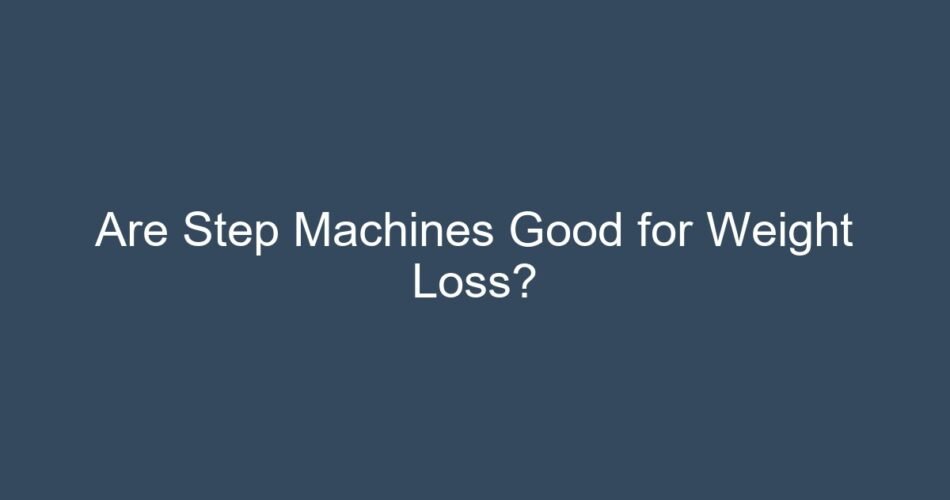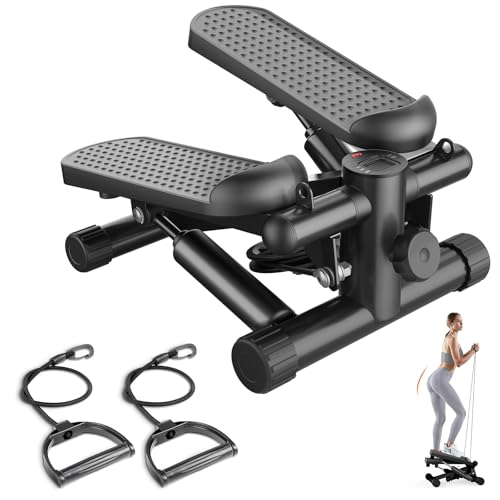Wondering if stair stepping is worth the effort for fitness goals? The quick answer to are step machines good for weight loss is absolutely yes, due to their unique combination of high-intensity cardio and functional strength training.
Are Step Machines Good for Weight Loss? Yes, step machines are exceptionally good for weight loss and efficient calorie burning. These machines, often called stair climbers or steppers, closely mimic the strenuous action of climbing stairs, engaging the body’s largest muscle groups for maximum metabolic output. Consistent use of a stair climber, combined with a sensible nutrition plan, provides a powerful, low-impact tool for achieving sustainable fat loss goals.
High Calorie Burn and Metabolic Rate
Step machines are renowned in the fitness community for their ability to generate an extremely high calorie burn in a relatively short period. Unlike standard walking or cycling, the motion of continuous climbing requires the body to constantly lift its weight against gravity.
🛒 Recommended Product
This sustained, high-intensity effort elevates the heart rate significantly, making stair climbing an excellent form of cardiovascular conditioning. A person weighing 180 pounds can burn between 550 and 800 calories per hour on a step machine, depending on the pace and resistance level. This places the stair stepper among the most effective calorie-burning cardio machines available, often surpassing the calorie expenditure of a treadmill running at a moderate pace.
The EPOC Effect
A crucial advantage of using the step machine is its potential to trigger a significant Excess Post-Exercise Oxygen Consumption (EPOC), often referred to as the “afterburn effect.” Because the machine demands such effort from the large muscles of the lower body, the intensity often reaches levels that classify the workout as High-Intensity Interval Training (HIIT).
This intensive effort forces the body to consume more oxygen after the workout is complete, maintaining an elevated metabolism for hours afterward. This means you continue to burn calories even while resting, amplifying your total daily energy expenditure and accelerating fat loss.
Step Machines vs. Other Cardio Equipment
A common question among fitness enthusiasts is whether step machine workouts provide a superior fat loss benefit compared to other popular equipment. The answer often depends on the user’s fitness level, joint health, and specific goals, but stair climbers offer a unique dual benefit of cardio and resistance.
For individuals wondering are step machines good for weight loss in comparison to an elliptical or bike, the key difference lies in the vertical resistance. While ellipticals offer an overall lower-impact experience, they typically distribute the effort across the whole body (arms and legs), often leading to a slightly lower maximum calorie burn rate compared to the pure lower-body drive of a stair climber.
Step machines force a high degree of muscle activation against gravity, which provides a level of resistance similar to strength training, something stationary bikes or treadmills generally lack.
🛒 Recommended Product
| Cardio Machine | Primary Focus | Resistance Mechanism | Impact on Joints | Average Calories Burned (180 lbs/hour) |
|---|---|---|---|---|
| Step Machine/Stair Climber | Lower Body Strength & Cardio | Vertical Gravity/Body Weight | Moderate (Low Impact if pace is controlled) | 550 – 800+ |
| Treadmill (Running) | Cardio | Velocity/Incline | High | 600 – 900 (High Incline) |
| Elliptical Trainer | Full Body Cardio | Mechanical Friction/Piston | Very Low | 450 – 650 |
| Stationary Bike | Lower Body Cardio | Magnetic/Friction Brake | Very Low | 500 – 750 (Spinning) |
The Mechanical Advantage: Building Lean Muscle
Weight loss success is not solely measured by the scale; it is heavily influenced by body composition—the ratio of fat mass to lean muscle mass. Step machines provide a distinct advantage in this area because the climbing motion is functionally equivalent to performing dozens of short, weighted lunges or squats.
The primary muscle groups activated on a step machine are the largest and most powerful in the human body:
- Gluteal Muscles (Glutes): The glutes are heavily engaged with every upward step, crucial for propulsion and hip extension. Stronger glutes improve posture and increase calorie expenditure.
- Quadriceps (Quads): The front thigh muscles are constantly working to extend the knee and lift the step.
- Hamstrings and Calves: These support muscles stabilize the motion and assist in pushing off.
Building lean muscle is fundamentally important for long-term weight management because muscle tissue is metabolically active. The more muscle mass you carry, the higher your basal metabolic rate (BMR) will be. By combining intense cardio with resistance that builds these key lower-body muscles, stair climbing optimizes the body’s ability to burn calories both during and after the workout.
Maximizing Fat Loss on the Stepper
While the step machine itself is an effective tool, technique and consistency are vital to maximize the results. Many users unintentionally minimize the effectiveness of the workout by leaning too heavily on the support bars. This practice transfers the effort from the legs and core to the arms, reducing the total muscular load and significantly decreasing the calorie burn.
To ensure you are fully utilizing the machine for maximum weight loss benefits, focus on the following techniques:
- Maintain Upright Posture: Keep your hands lightly resting on the rails for balance only. Let your core and glutes stabilize your body.
- Full Foot Contact: Avoid stepping only on the balls of your feet. Engage the entire foot to maximize hamstring and glute activation.
- Implement Intervals: Use high-intensity efforts (speed bursts) followed by recovery periods (a slower, steady climb). This maximizes the EPOC effect and prevents the body from adapting too quickly to the movement.
- Incorporate Backward Climbing: Safely moving backward (if the machine allows and you are balanced) engages the hamstrings and calves in new ways, promoting total lower body strength and variety.
Ultimately, the best way to achieve optimal fat loss is through consistency. Aim for three to five 30-to-60-minute sessions per week, varying the speed and resistance settings to challenge your cardiovascular fitness continually.
🛒 Recommended Product
Conclusion
Step machines are a highly effective, low-impact choice for anyone targeting serious weight loss and cardiovascular improvement. By combining intense cardio capacity with genuine resistance training, the stair climber maximizes calorie expenditure and accelerates the development of metabolically active lean muscle, answering the question are step machines good for weight loss with a resounding affirmation of their benefits.
Scientific References & Research
The following peer-reviewed research papers provide additional scientific context:
-
AD Kuo (2007).
Choosing your steps carefully
[External Link] -
TM Cook et al. (1992).
EMG comparison of lateral step-up and stepping machine exercise
[External Link] -
J Um et al. (2016).
STEP-NC machine tool data model and its applications
[External Link]
Note: External research links are provided for educational purposes and do not necessarily represent endorsement.
Frequently Asked Questions About Are Step Machines Good for Weight Loss?
Q. Is using a step machine alone sufficient for achieving significant weight loss, or are other factors necessary?
A. While the step machine is an excellent cardiovascular tool for burning calories, it is generally not sufficient for significant, sustained weight loss on its own. Comprehensive weight management requires combining consistent aerobic exercise, such as stepping, with strength training to build metabolism-boosting muscle mass. Crucially, dietary changes that ensure a consistent caloric deficit remain the most important factor in achieving and maintaining substantial weight loss results.
Q. Does the low-impact nature of step machines diminish their effectiveness for weight loss compared to high-impact exercises like running?
A. No, the low-impact nature of step machines does not inherently diminish their effectiveness for weight loss, as effectiveness is primarily determined by workout intensity and duration. Step machines allow individuals, especially those with joint issues, to maintain high-intensity workouts for longer periods without the risk of impact injury, often resulting in comparable or even higher total calorie burn than shorter, high-impact sessions. The ability to exercise consistently without pain is a major advantage that directly contributes to long-term adherence and weight loss success.
Q. How does incorporating interval training (HIIT) on a step machine optimize fat burning and weight loss compared to steady-state stepping?
A. Incorporating high-intensity interval training (HIIT) on a step machine significantly optimizes fat burning through the “afterburn effect,” known as excess post-exercise oxygen consumption (EPOC). HIIT sessions involve alternating short bursts of maximal effort with periods of rest, which dramatically elevates the metabolism both during and long after the workout is complete. This method is highly effective for improving cardiovascular fitness and promoting greater overall fat utilization compared to continuous, moderate-intensity exercise.
Q. Beyond calorie burning, what secondary physiological benefits of using a step machine support a successful weight loss journey?
A. Beyond direct calorie expenditure, step machines offer secondary benefits that support weight loss, including significant improvements in cardiovascular health and lower body muscle endurance. Strengthening the major leg and gluteal muscles increases overall muscle mass, which in turn elevates the basal metabolic rate, meaning the body burns more calories even at rest. Furthermore, regular exercise helps regulate hormones related to appetite and stress, making adherence to a healthy diet easier.
Q. Should step machines be utilized primarily for fat loss or for building muscle in the lower body?
A. Step machines are primarily utilized for cardiovascular conditioning and fat loss, offering excellent aerobic benefits and calorie expenditure. While the stepping motion engages and strengthens the glutes, hamstrings, and quads, the resistance level is usually too low to induce significant muscle hypertrophy (bulk) alone. For optimal lower body muscle building, users should supplement step machine use with dedicated resistance training or utilize models that allow for very high resistance settings.
Related Articles
What Is the Best Workout Machine for Weight Loss?
Trying to determine what is the best workout machine for weight loss? While several options deliver results, the rowing machine often provides the max…
Do Vibrating Weight Loss Machines Work?
Do vibrating weight loss machines work? The scientific data is clear: while these vibration therapy plates offer proven benefits like muscle stimulati…
Treadmill Workouts for Buttocks: Sculpt and Tone Your Glutes
Getting fit and shaping your buttocks can be challenging. Treadmill workouts might be the solution you need. Treadmill workouts are not just for cardi…
When you purchase a product through Amazon links on EllipticalKing.com, we may earn a small commission at no extra cost to you. This helps support the site and keep our content free.




